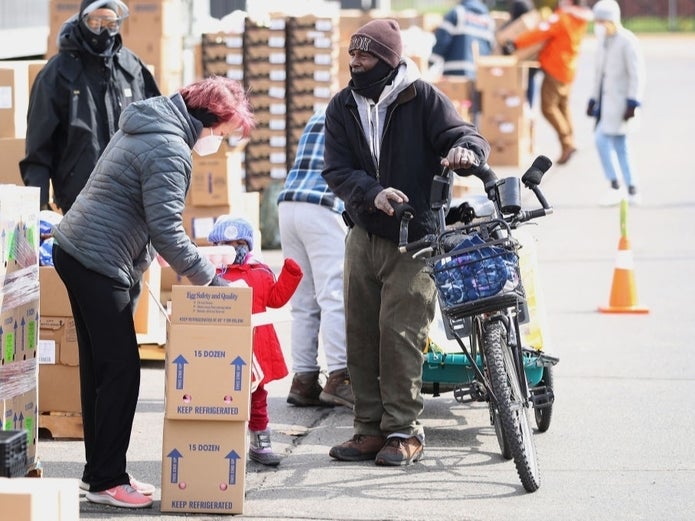Hunger and food insecurity are increasing dramatically across America. Patch has teamed with Feeding America to get more food on the tables of our neighbors in an ongoing, sustained effort. This story, running nationally across our network of Patches, provides information on how you can help.
ACROSS AMERICA — Among the many casualties of the coronavirus pandemic is a sense of security at America’s dinner tables. More than 54 million Americans may find themselves staring at sparse or empty plates before 2020 is over, according to Feeding America, the nation’s largest hunger-relief organization.
That’s 17 million more Americans struggling with food insecurity than before the pandemic. That’s about twice the population of New York City.Ring | Featured AdvertiserMystery Solved: What Happened to My Patio Furniture?When Gentille’s patio furniture was damaged overnight, she knew she could depend on her Ring Floodlight Cam to find out who was behind it.Watch Now
Any one of the hungry could be your next-door neighbor — someone like Adriana Rosas, a single mom who cut every bit of fat out of her budget after losing her job to the pandemic but still doesn’t have enough money to adequately feed her family.
“This is the fourth week without a paycheck,” Rosas told Feeding America earlier this year while picking up food for her family at a distribution site in New Braunfels, Texas. “I was strategic with my last one and stretched it out as much as possible. After paying for rent and electricity, it was then that I can think about groceries — it’s crazy to say that groceries come last.”Subscribe
People like Rosas, whose lives were thrown into an economic crisis by the pandemic, are found in every county and parish in the country, said Kathryn Strickland, Feeding America’s chief network officer. The Chicago-based charity blankets the country with 200 member food banks that serve and supply 60,000 food pantries, kitchens and meal programs.
Food insecurity has always been a problem in the United States.
“Even in the best of times, we served people in crisis, people with nowhere to turn for their next meal,” Strickland said.
But the pandemic is exacerbating food insecurity, challenging not only American families but also Feeding America with a host of operational difficulties, including fewer volunteers and reduced retail donations because of store closings.
Story continues below.
An estimated 37.2 million Americans, including 11 million children, were considered food insecure under U.S. Department of Agriculture guidelines before the pandemic sent millions more into an economic tailspin with colliding crises.
The number of people struggling to get enough food actually decreased in 2018, according to Feeding America’s most recent “Map the Meal Gap” study, but Americans’ annual meal budget still fell nearly $19.5 billion short.
Now, pandemic-related food insecurity overlaps with massive job losses, the end of federal coronavirus unemployment payments to 25 million Americans, a looming eviction crisis that could leave 40 million Americans homeless, and business and home losses in natural disasters such as the California wildfires and Hurricane Laura.
Those crises have come on top of other factors that contribute to food insecurity: low wages, chronic and acute health problems, high medical costs and isolation.
How Food Insecurity Looks
Food insecurity has always looked different in America from household to household.
The USDA, which oversees the nation’s food and nutrition programs, defines food insecurity as “a lack of consistent access to enough food for an active, healthy life.”
Hunger is a physical sensation, and it hurts.
In some cases, moms may skip meals so their children can eat. Plates may be short on healthy fruits and vegetables. In multigenerational households, grandparents may go without. Seniors who have long struggled to make their Social Security and other benefits last may think they don’t have the right to speak up with so many people in need.
Strickland said a surprise was revealed by a new partnership between the Community Food Bank of Central Alabama — where she was the executive director before joining Feeding America — and senior living facilities.
“I was shocked by the number of residents who said they were grateful, because they had run out of food and didn’t want to share their burden,” she said. “The facility managers had no idea.”
Food insecurity and hunger aren’t the same, though they can be inexorably linked.
Paul Campbell is food insecure.
He was laid off from his job in Maryland and turned to the Capital Area Food Bank as the money in his bank account dwindled.
“The unemployment and the shortage in money from what I was making compared to what I’m getting now — not having to buy as much food as I used to — it makes a great difference,” Campbell told Feeding America.
But in households with very low food security, hunger and the prospect of starvation are real, life-threatening concerns.
“A man in Walker County, Alabama, lost his construction job after 20 years,” Strickland said, relating a story shared with food pantry volunteers. “He had sold his tools to buy food, was a caretaker for his brother who was ill, and he said the food pantry was the only thing keeping him from starving.”
Access to healthy, nutritious food is among the most fundamental of human needs. Food insecurity doesn’t discriminate, especially during a pandemic.
It’s often thought of as a “poor people’s problem,” but not all people living in poverty are food insecure, and not all food insecure people live in poverty. Food insecurity is a complex issue sandwiched in with other systemic challenges, including poverty, low wages, affordable housing shortages, chronic and acute health problems, high medical costs and social isolation.
Many food-insecure people have characteristics that put them at a higher risk for severe illness associated with COVID-19, including Black Americans, Latinos, elderly and low-income Americans.
And workers who have service occupations or work in the leisure and hospitality industry are more likely to be food insecure and are at risk of further hardship as many businesses have been forced to close and lay off staff.
Some of the newly food insecure are also people who never thought they’d be filling their cupboards and refrigerators with food from a pantry.
“Our members are reporting that many of the people they’re serving have never sought food assistance before,” Strickland said. “Some people are reporting that people who formerly donated to food banks are now seeking assistance.”
Creativity In The Pandemic
Several of Feeding America’s member food banks have taken creative approaches to make it easier for people to socially distance during the pandemic and still have access to healthy food.
The Northern Illinois Food Bank in suburban Chicago developed a system Strickland compares to the “charitable food version of Instacart,” the online grocery store app.
People can order food from their phone and pick it up at a distribution location without leaving their cars. That not only provides for coronavirus social distancing but also “preserves the privacy of people who may experience a stigma from seeking help,” Strickland says.
In Tampa Bay, Florida, the owners of a catering company that lost about $500,000 in high-end wedding, banquet and corporate business found a way to save the business and feed 500 children across Pinellas County through a partnership with Feeding Tampa Bay.
“It’s very fulfilling, knowing who this food is for,” Jeff Simpson, one of the owners of Delectables Fine Catering, told the Tampa Bay Times. “It’s far from what we were doing. But it’s saved our business and helped so many families.”
When schools in Indianapolis shuttered last spring, Gleaners Food Bank of Indiana and Indianapolis Public Schools teamed to fill school buses with 17-pound boxes of food and deliver them to locations across Indianapolis.
Neighbors can help out each other in smaller but important ways.
“Food banks always welcome food drives and food donations,” Strickland said. “If people are concerned about social distancing, they can have virtual food drives and have people contribute online.”
Also, she said, “food banks are very good stewards of cash. What we’re able to do with $1 is leverage it and purchase food at wholesale. It goes farther than if we purchased food at the grocery store.”
Feeding America says the realities of the pandemic underscore the need not only for private support for the local food banks working to make sure their neighbors have enough groceries, but also for policy reform.
Specifically, Feeding America called on the Trump administration to strengthen and invest in federal food assistance programs to:
- Boost the maximum SNAP — Supplemental Nutrition Assistance Program — benefit by at least 15 percent;
- Increase the minimum SNAP benefit from $16 to $30; and
- Suspend all SNAP rules that would eliminate or cut SNAP benefits for people facing hunger.
Every dollar donated, every hour given in volunteer service and every letter written to Congress will make a difference, Strickland said.
“Establish a relationship with your local food bank,” she said. “There are numerous volunteer opportunities, even in the time of the pandemic. Having those relationships with neighbors can raise general awareness of food insecurity, often right in our own communities.”
PEABODY, PATCH






